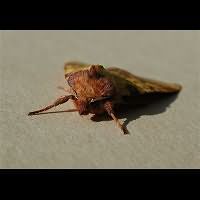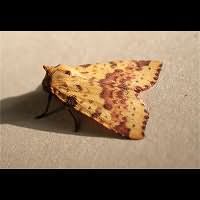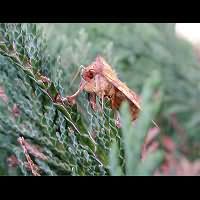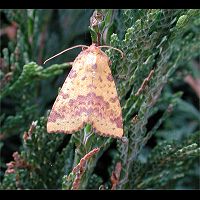Pink-barred Sallow Xanthia togata
The Pink-barred Sallow is one of the most beautiful Owlet Moths. There is an attractive contrast between the warm yellow ground colour and the pinkish or purplish markings and band on the wings. The size of both the markings and the band is rather variable. Actually there is only one really similar species: the Sallow. Luckily there is one striking difference between the two species: the head of the Sallow is yellow, while the head of the Pink-barred Sallow is purplish or pinkish brown like the markings on the wings. Once you pay attention to this feature, the Pink-barred Sallow is unmistakable. The wingspan varies from 28 to 36mm.
The eggs are being laid by the end of summer and in autumn. They are deposited in small rows, one after the other, near the bud of a flower of the host plant. The eggs do hatch in March after overwintering. The small caterpillars of the Pink-barred Sallow look for the bud, live in the flower and eat it. By the time the catkins fall down, the caterpillars fall down with them and continue feeding on low growing plants beneath the trees. Once fully grown they dig a small hole in the ground in which a cocoon is spun. The caterpillars remain inside the cocoon motionless for four to six weeks, before pupating. By the beginning of August the first moths appear. The first host plants of which the catkins are eaten are sallow and poplars. The caterpillar is very hard to tell apart from the caterpillar of some other species and not very distinct. It has a rather undefined redbrownish ground colour. The back often is just a shade darker. There is a faint, sometimes hardly visible dorsal line. On the sides are one or two other light lines, if visible. The head is brown showing dark brown markings. The larvae may be 27 to 32mm in length.
The Pink-barred Sallow is on the wing from the end of August to the beginning of October. Occasionally a specimen is seen on the wing in spring or summer. The moth is not attracted to light very much, but it will come to sugar readily. The adults visit Ivy blossoms and rotting berries. A common species all over Britain, including northern parts, such as Scotland, the Hebrides and Orkney. In other parts of Europe a common species too.
The Pink-barred Sallow is one of the most beautiful Owlet Moths. There is an attractive contrast between the warm yellow ground colour and the pinkish or purplish markings and band on the wings. The size of both the markings and the band is rather variable. Actually there is only one really similar species: the Sallow. Luckily there is one striking difference between the two species: the head of the Sallow is yellow, while the head of the Pink-barred Sallow is purplish or pinkish brown like the markings on the wings. Once you pay attention to this feature, the Pink-barred Sallow is unmistakable. The wingspan varies from 28 to 36mm.
The eggs are being laid by the end of summer and in autumn. They are deposited in small rows, one after the other, near the bud of a flower of the host plant. The eggs do hatch in March after overwintering. The small caterpillars of the Pink-barred Sallow look for the bud, live in the flower and eat it. By the time the catkins fall down, the caterpillars fall down with them and continue feeding on low growing plants beneath the trees. Once fully grown they dig a small hole in the ground in which a cocoon is spun. The caterpillars remain inside the cocoon motionless for four to six weeks, before pupating. By the beginning of August the first moths appear. The first host plants of which the catkins are eaten are sallow and poplars. The caterpillar is very hard to tell apart from the caterpillar of some other species and not very distinct. It has a rather undefined redbrownish ground colour. The back often is just a shade darker. There is a faint, sometimes hardly visible dorsal line. On the sides are one or two other light lines, if visible. The head is brown showing dark brown markings. The larvae may be 27 to 32mm in length.
The Pink-barred Sallow is on the wing from the end of August to the beginning of October. Occasionally a specimen is seen on the wing in spring or summer. The moth is not attracted to light very much, but it will come to sugar readily. The adults visit Ivy blossoms and rotting berries. A common species all over Britain, including northern parts, such as Scotland, the Hebrides and Orkney. In other parts of Europe a common species too.








